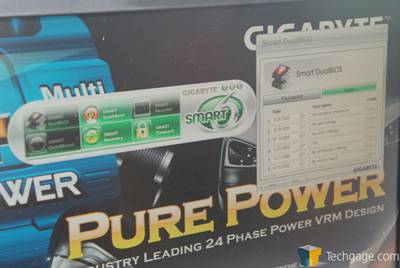From our front-page news:
Out of all the motherboard vendors, the company who seems to care most about bundled software would have to be Gigabyte. While some others release software that's entirely clunky and not fun to use, Gigabyte tries to refine theirs as much as possible, in order to make them both look good, and easy to use. Such new software was shown off at Computex, and I have to say, if it's not all entirely useful, it is at least interesting.
A new software bundle in some upcoming motherboards is called Ultra6, and it's comprised of Smart DualBIOS, QuickBoost, QuickBoot, Recorder and TimeLock. One of the more interesting of the bunch would have to be DualBIOS. For this feature, Gigabyte expanded the physical size of the BIOS to about 16MB, in order to allow users to save additional information within.
What kind of information may change over time, but the demo they had gave an example of saving your collection of passwords. For example, when using the feature, you could type in your passwords and also the site names for each, then save it to the BIOS. If you happen to forget a password later on, you can use this feature and input the master password in order to see whatever is stored. This will undoubtedly be a niche feature, but it's neat nonetheless.
Then there is Recorder, which acts as a system logger. Here, the software can record a variety of information, including what was done on your PC recently, such as copying files to a thumb drive. We also have Recovery, which is set to compete with such technologies as Time Machine from Apple. If this software works well, it would prove to be a great addition to Gigabyte's boards.
There's also QuickBoot, which somehow improves both the boot speed of the POST process and also the Windows' loading. Aside from these, there were other software tools shown, such as updated and worthwhile overclocking tools, and we'll be sure to take a look at all of them when they hit upcoming P55 and revised X58 motherboards.
A new software bundle in some upcoming motherboards is called Ultra6, and it's comprised of Smart DualBIOS, QuickBoost, QuickBoot, Recorder and TimeLock. One of the more interesting of the bunch would have to be DualBIOS. For this feature, Gigabyte expanded the physical size of the BIOS to about 16MB, in order to allow users to save additional information within.
What kind of information may change over time, but the demo they had gave an example of saving your collection of passwords. For example, when using the feature, you could type in your passwords and also the site names for each, then save it to the BIOS. If you happen to forget a password later on, you can use this feature and input the master password in order to see whatever is stored. This will undoubtedly be a niche feature, but it's neat nonetheless.
Then there is Recorder, which acts as a system logger. Here, the software can record a variety of information, including what was done on your PC recently, such as copying files to a thumb drive. We also have Recovery, which is set to compete with such technologies as Time Machine from Apple. If this software works well, it would prove to be a great addition to Gigabyte's boards.
There's also QuickBoot, which somehow improves both the boot speed of the POST process and also the Windows' loading. Aside from these, there were other software tools shown, such as updated and worthwhile overclocking tools, and we'll be sure to take a look at all of them when they hit upcoming P55 and revised X58 motherboards.

